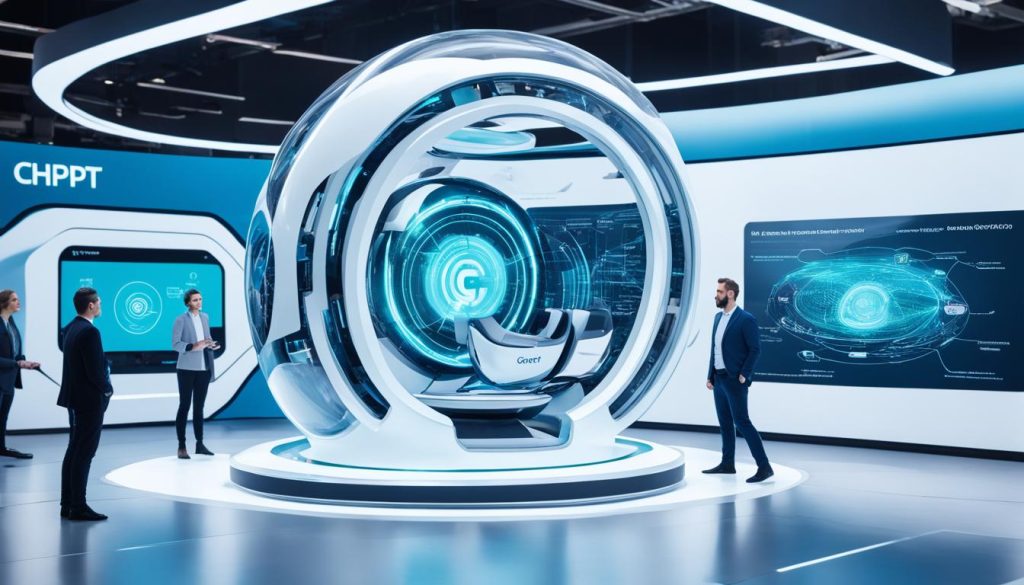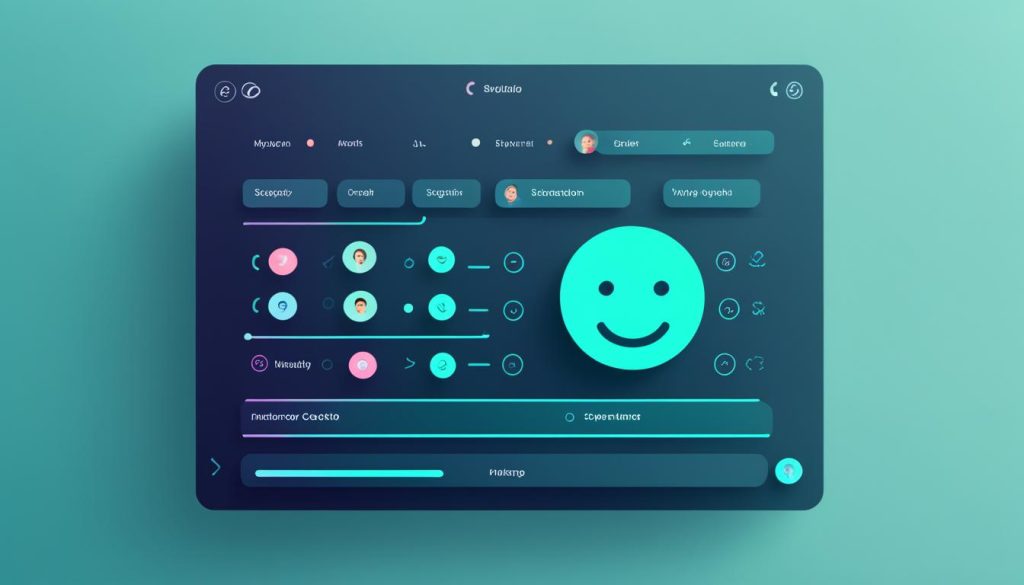As we stand on the brink of a technological revolution, one question looms large: What will the future of ChatGPT hold in the year 2025? This AI language model, developed by OpenAI, has already captured the world’s imagination, transforming the way we interact with machines and pushing the boundaries of natural language processing (NLP).
Brace yourself, for the conversational AI landscape is poised to undergo a dramatic transformation, one that will redefine how we communicate, collaborate, and conduct business. The advancements in NLP have already taken ChatGPT and its counterparts to unprecedented heights, and the future promises even more remarkable leaps forward.

But what exactly does the future hold for this groundbreaking technology? Will ChatGPT continue to evolve, becoming more intelligent, empathetic, and useful? Or will it face challenges and limitations that we cannot yet foresee? Join us as we delve into the captivating possibilities that lie ahead, exploring the potential of AI assistants, multimodal AI, and the ethical considerations that will shape the future of this transformative technology.
Key Takeaways
- The rapid advancements in natural language processing are driving the evolution of conversational AI models like ChatGPT.
- The year 2025 is expected to be a significant milestone in the development of AI language models and their integration into various industries.
- Emerging technologies like multimodal AI and personalized AI assistants are poised to transform how we interact with machines.
- The future of ChatGPT will be shaped by both technological breakthroughs and ethical considerations, as the implications of this powerful technology become increasingly complex.
- Understanding the potential and challenges of ChatGPT in 2025 can help us prepare for the transformative changes that lie ahead.
The Rise of Conversational AI and Natural Language Processing
The rapid advancements in natural language processing (NLP) have paved the way for a new era of conversational AI models that revolutionize how machines understand and interact with human language. NLP, the driving force behind these breakthroughs, empowers machines with the ability to comprehend, process, and respond to natural language in real-time with impressive accuracy.
Unleashing the Power of NLP in Conversational AI
The integration of NLP into conversational AI platforms has unlocked unprecedented capabilities, allowing machines to engage in more natural, contextual, and meaningful dialogues. These AI-powered assistants can now understand the nuances of human communication, interpret emotional cues, and tailor their responses accordingly, fostering a more seamless and intuitive user experience.
The Growth of GPT-3 and Pre-Trained Language Models
At the forefront of this revolution is GPT-3, OpenAI’s groundbreaking language model that has pushed the boundaries of what’s possible in natural language processing. With its ability to generate human-like text, GPT-3 and other pre-trained language models have become the foundation for developing increasingly sophisticated conversational AI systems that can engage in more intelligent and natural conversations.
Multilingual NLP: Bridging Language Barriers
The advancements in multilingual NLP have further expanded the reach and applicability of conversational AI, enabling machines to understand and communicate in multiple languages with ease. This has profound implications, breaking down language barriers and empowering global communication and collaboration in ways never before imagined.
As these cutting-edge technologies continue to evolve, the future of conversational AI and natural language processing holds immense promise, transforming the ways we interact with machines and paving the way for a more seamless, intelligent, and inclusive digital world.
Shaping the Future of Communication
As the advancements in chat gpt in 2025 and conversational ai continue to reshape the landscape of communication, the implications are profound and far-reaching. In a world where information overload is a growing concern, the integration of language understanding and personalized ai into Conversational AI models holds the promise of transforming how we process and comprehend complex information.
Imagine a scenario where a user can simply converse with a chat gpt in 2025 system and receive a concise, tailored summary of a lengthy document or research paper. This NLP-powered ability to distill complex content into easily digestible insights empowers users to quickly grasp the essence of information without being overwhelmed by the sheer volume of available data.
Beyond mere summarization, the future of Conversational AI envisions seamless multilingual interactions, breaking down language barriers and enabling effortless communication across diverse cultures and geographies. This personalized ai approach not only enhances understanding but also fosters more meaningful and inclusive exchanges, paving the way for a more connected global community.
As we look towards the horizon, the chat gpt in 2025 and conversational ai revolution holds the potential to transform the way we communicate, collaborate, and consume information, shaping a future where knowledge and understanding are more accessible than ever before.
| Key Trends in Conversational AI | Potential Impact |
|---|---|
| Advancements in language understanding | Seamless human-machine interactions, enabling more intuitive and natural communication |
| Integration of personalized ai technologies | Tailored user experiences, improved information processing, and enhanced decision-making |
| Breakthroughs in chat gpt in 2025 models | Transformative potential in various industries, from customer service to content creation |
| Conversational ai in multilingual environments | Overcoming language barriers, fostering global collaboration and cultural exchange |
Transforming Business Operations
As the landscape of conversational ai continues to evolve, one of the most exciting prospects is the synergy between human and machine capabilities. The lines between human and ai assistants interactions are blurring, as AI systems become increasingly proficient at understanding context, emotions, and nuances in communication.
The Art of Man-Machine Collaboration
This newfound ability to empathize and communicate more effectively is paving the way for a new era of personalized ai solutions. By integrating chat gpt in 2025 technology into business operations, organizations can create more personalized and engaging experiences for their customers, ultimately enhancing user satisfaction and the overall quality of engagement.
The fusion of human expertise and AI-driven insights is transforming the way companies approach problem-solving, decision-making, and process optimization. Conversational ai systems can now assist employees in streamlining tasks, automating repetitive workflows, and providing real-time access to critical information, freeing up valuable time and resources.
Furthermore, the integration of chat gpt in 2025 technology into customer service and support channels is revolutionizing the way businesses interact with their clients. Personalized, context-aware responses and the ability to address queries with empathy and nuance have transformed the customer experience, leading to increased loyalty, reduced churn, and enhanced brand reputation.
As the realm of conversational ai continues to expand, the possibilities for transforming business operations are limitless. The future of man-machine collaboration promises to redefine the way organizations operate, innovate, and serve their customers, paving the way for a more efficient, personalized, and adaptable business landscape.
Embracing the Promising Future
As we stand on the cusp of the future, it is evident that Conversational AI, driven by groundbreaking Natural Language Processing (NLP) advancements, is set to redefine how we communicate, collaborate, and conduct business. OpenAI’s GPT-3 and Multilingual NLP technology are spearheading this transformation, making language barriers a thing of the past and enabling machines to comprehend human language with astonishing accuracy.
The implications of these developments in chat gpt in 2025 and ai language models are profound and far-reaching. In a world where information overload is a real concern, NLP-powered Conversational AI holds the promise of distilling lengthy documents into concise summaries, allowing users to quickly and effectively grasp the essence of a report, article, or research paper without wading through pages of content.
As we embrace this promising future, the ethical considerations surrounding ai ethics come to the forefront. Ensuring that these advanced Conversational AI systems are aligned with human values and societal well-being will be a crucial challenge that researchers, policymakers, and the public must collectively address. By striking the right balance between technological progress and ethical responsibility, we can harness the transformative potential of chat gpt in 2025 and ai language models to enhance our lives and shape a better tomorrow.

Diving Into Complexity
As the field of artificial intelligence continues to evolve, the landscape of chat gpt in 2025 and ai language models is becoming increasingly complex. The advancements in natural language processing and multimodal ai have opened up new frontiers, demanding specialized expertise from a growing community of AI professionals.
Specialized AI Professionals
The rise of personalized ai and the need for ai ethics have created a surge in demand for highly skilled AI experts. These professionals, versed in the intricacies of machine learning, neural networks, and natural language processing, are tasked with navigating the nuances of developing and deploying intelligent systems that can seamlessly integrate with human workflows and decision-making processes.
Tackling Advanced Problems
As the capabilities of chat gpt in 2025 and other ai language models continue to expand, the challenges they face become increasingly sophisticated. From understanding complex contextual cues to addressing ai ethics concerns, these advanced AI systems require a deep understanding of the underlying technologies and their societal implications. Specialized AI professionals are at the forefront of tackling these complex problems, driving the field forward and shaping the future of human-machine collaboration.
Multimodal AI: The Future of Sensor Fusion
As the landscape of Artificial Intelligence (AI) continues to evolve, the emergence of multimodal AI is poised to redefine the way machines perceive and interact with the world around them. This innovative approach combines chat gpt in 2025, ai language models, visual processing, and other sensory inputs, enabling AI systems to develop a more comprehensive understanding of their environment and the users they serve.
Combining Text, Vision, and More
The recent advancements in multimodal ai have been nothing short of remarkable. Groundbreaking models like ChatGPT have already demonstrated their ability to seamlessly integrate text and visual inputs, allowing users to engage in discussions and receive insights based on a rich tapestry of information. This capability opens up a world of possibilities, where AI can become a true partner in problem-solving, decision-making, and creative endeavors.
Emerging personalized ai assistants are set to take this integration even further, blending sensory inputs such as sound, touch, and even smell to create truly immersive and personalized experiences. As these technologies mature, the line between human and machine interaction will continue to blur, leading to more intuitive and naturalistic communication.
Practical Applications of Multimodal Models
The practical applications of multimodal ai are vast and far-reaching. In fields such as healthcare, multimodal ai can analyze medical images, patient records, and real-time sensor data to provide more accurate diagnoses and personalized treatment plans. In the realm of education, these models can create adaptive learning experiences that cater to individual student needs, leveraging a diverse array of multimedia content to enhance comprehension and engagement.
Similarly, in the business world, multimodal ai can revolutionize customer service, sales, and marketing by delivering hyper-personalized interactions that seamlessly blend text, visuals, and even voice-based interactions. The potential for multimodal ai to transform industries and improve people’s lives is truly exciting.

As we look towards the future, the integration of chat gpt in 2025, ai language models, and multimodal ai will undoubtedly play a pivotal role in shaping the way we interact with technology and solve complex problems. The possibilities are endless, and the benefits to individuals, industries, and society as a whole are poised to be transformative.
chat gpt in 2025: A Glimpse into the Future
As we peer into the future, the advancements in Conversational AI and Natural Language Processing (NLP) are poised to reshape our interactions with technology. In 2025, the chat gpt in 2025 experience will be defined by an even more seamless and personalized dialogue, where ai assistants become indispensable partners in our daily lives.
Imagine a world where ai language models can effortlessly summarize lengthy reports, distilling complex information into concise, easy-to-digest insights. This NLP-powered capability will empower users to quickly grasp the essence of a document, allowing them to make informed decisions without being overwhelmed by data overload.
Furthermore, the integration of personalized ai will deliver a truly customized experience, where the chat gpt in 2025 system understands the unique preferences and needs of each user. This hyper-personalization will not only enhance productivity but also foster a deeper sense of trust and connection between humans and their ai assistants.
As we stand on the cusp of this transformative future, the possibilities offered by the convergence of Conversational AI and NLP are truly exciting. The chat gpt in 2025 will be a testament to the remarkable advancements in this field, serving as a powerful tool to streamline our lives, amplify our capabilities, and redefine the way we interact with technology.
The Concentric Circles of AI Alignment
As the realm of chat gpt in 2025 and ai language models continues to evolve, the topic of ai ethics and ai alignment has emerged as a critical area of focus. This multifaceted challenge extends far beyond the technical aspects of model development, encompassing a web of interconnected considerations that must be addressed to ensure the responsible and beneficial integration of these powerful technologies into our societies.
Aligning Models to Loss Functions
At the core of AI alignment lies the imperative to ensure that the objectives and loss functions driving the development of chat gpt in 2025 and other ai language models are meticulously aligned with the desired outcomes and values of humanity. This requires a deep understanding of the complex societal implications of these technologies, as well as a commitment to continuously refine and optimize the models to uphold ethical principles and mitigate potential harms.
Researcher and Institutional Alignment
Beyond the technical considerations, the ai alignment challenge also demands a alignment of the researchers, institutions, and organizations responsible for shaping the future of chat gpt in 2025 and ai language models. This involves fostering a culture of ethical decision-making, promoting transparency, and establishing robust governance frameworks to ensure the responsible development and deployment of these transformative technologies.
Societal and Regulatory Alignment
Ultimately, the pursuit of ai alignment must extend beyond the confines of the research and development spheres, engaging with the broader societal and regulatory landscape. This necessitates open dialogues, multidisciplinary collaborations, and the development of comprehensive policies and frameworks that balance the immense potential of chat gpt in 2025 and ai language models with the imperative to protect individual rights, promote social justice, and safeguard the wellbeing of humanity as a whole.
ChatGPT’s Rapid Growth and Transformative Potential
The past year has witnessed a remarkable transformation in the world of artificial intelligence, with ChatGPT leading the charge. Launched by OpenAI just a year ago, ChatGPT has taken the world by storm, becoming the world’s fastest-growing consumer app of all time. This meteoric rise has not only captured the attention of the tech industry but has also unlocked the public’s imagination and discourse around the potential of ai language models, conversational ai, and personalized ai.
The “iPhone Moment” of AI
The author notes that the difference this last year has made has been remarkable, not just in technological progress or academic research, but in unlocking the public’s understanding and excitement about the transformative power of chat gpt in 2025. Much like the iPhone’s groundbreaking debut, which ushered in a new era of smartphones, ChatGPT has become the “iPhone moment” of artificial intelligence, capturing the public’s attention and sparking a wave of enthusiasm and speculation about the future of ai assistants.
Harnessing ChatGPT’s Potential
As the world eagerly anticipates the future of chat gpt in 2025, the possibilities for harnessing the power of this transformative technology are vast and exciting. From streamlining business operations to enhancing personal productivity, the versatility of ChatGPT and its underlying ai language models promises to revolutionize the way we work, communicate, and interact with technology. The potential for personalized ai to tailor experiences and solutions to individual needs further underscores the transformative potential of this groundbreaking innovation.
Limitations and Challenges of ChatGPT
As the world marvels at the capabilities of chat gpt in 2025, it’s important to acknowledge the limitations and challenges that this ai language models faces. One of the primary concerns is the accuracy and reliability of the responses generated by ChatGPT. Despite its impressive language understanding and generation abilities, the model is not a search engine and instead predicts the most statistically probable next word in a sentence based on its previous training and surrounding words.
Accuracy and Reliability Concerns
While ChatGPT can produce remarkably human-like responses, its outputs are not always accurate or reliable. The model can sometimes make mistakes, provide biased information, or even generate content that is inconsistent or contradictory. This limitation underscores the importance of critical thinking and fact-checking when relying on the information provided by ai language models like ChatGPT.
Intellectual Property and Copyright Issues
Another challenge facing ChatGPT is the issue of intellectual property and copyright infringement. The model’s ability to generate human-like text raises concerns about its potential to reproduce or plagiarize existing content without proper attribution. This can create legal and ethical dilemmas, particularly in academic and professional settings where plagiarism is a serious offense.
Job Displacement Fears
As chat gpt in 2025 and other ai language models become more advanced, there are growing concerns about their potential to displace human workers in various industries. From content creation and writing to customer service and administrative tasks, the increasing capabilities of these AI systems could lead to job losses and disruptions in the labor market. This issue highlights the need for careful consideration of the ai ethics and ai alignment implications as these technologies continue to evolve.
Conclusion
As we stand on the cusp of the future, it is evident that Conversational AI, driven by groundbreaking natural language processing (NLP) advancements, is set to redefine how we communicate, collaborate, and conduct business. OpenAI’s GPT-3 and Multilingual NLP technology are spearheading this transformation, making language barriers a thing of the past and enabling machines to comprehend human language with astonishing accuracy.
The implications of these advancements in chat gpt in 2025 and conversational ai are profound and far-reaching. From distilling lengthy documents into concise summaries to fostering more empathetic and effective interactions between humans and machines, the future of communication is poised for a profound shift.
However, the journey ahead is not without its challenges. AI language models and ai alignment must be carefully navigated to ensure ethical and responsible development, addressing concerns around accuracy, reliability, and the societal impact of these transformative technologies. As we embrace the promising future, it is crucial to strike a balance between harnessing the immense potential of conversational ai and upholding the principles of transparency, accountability, and trust.

